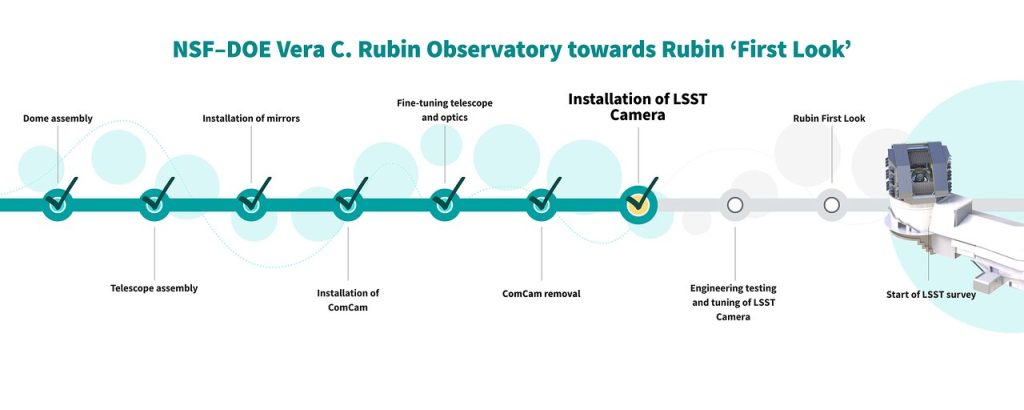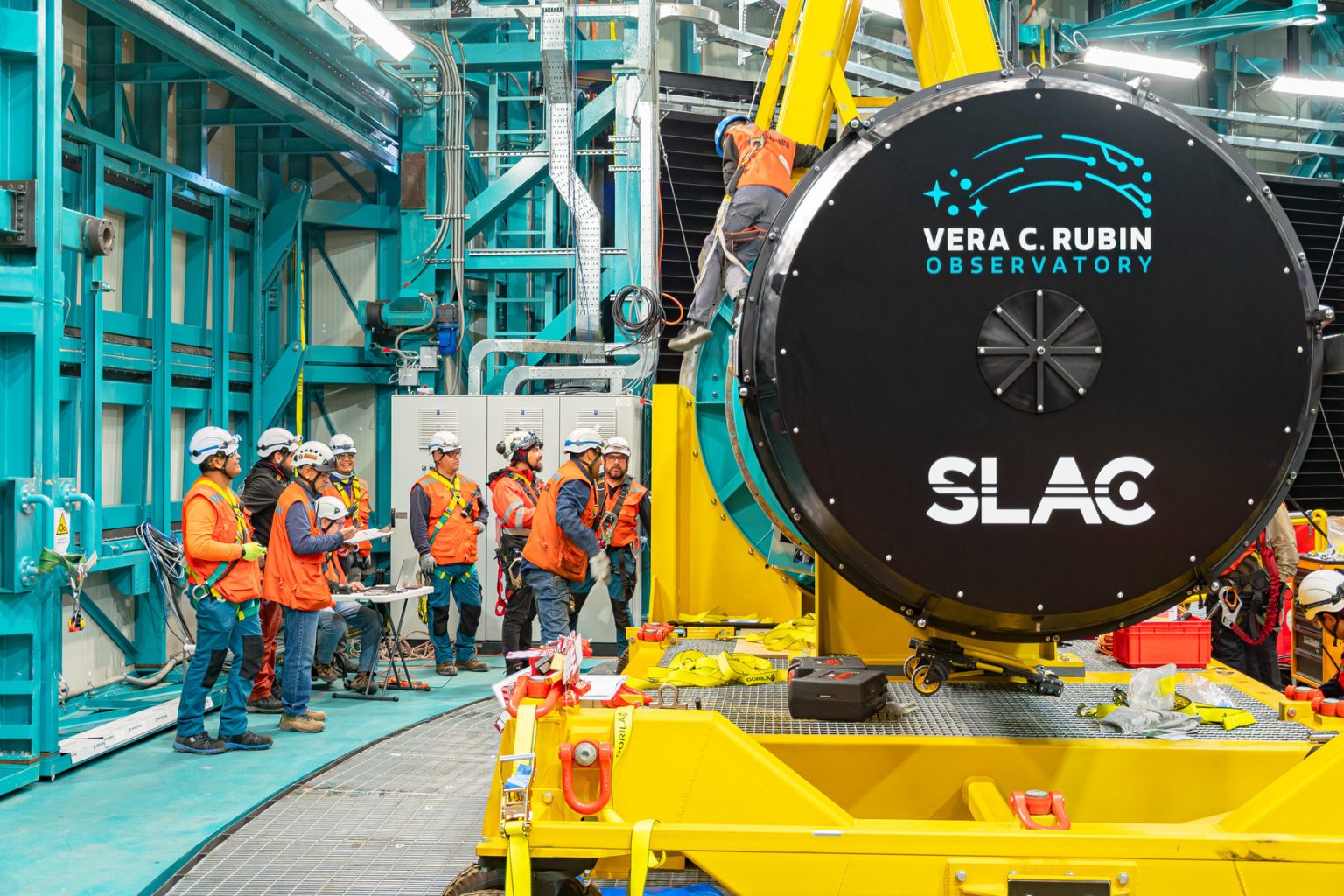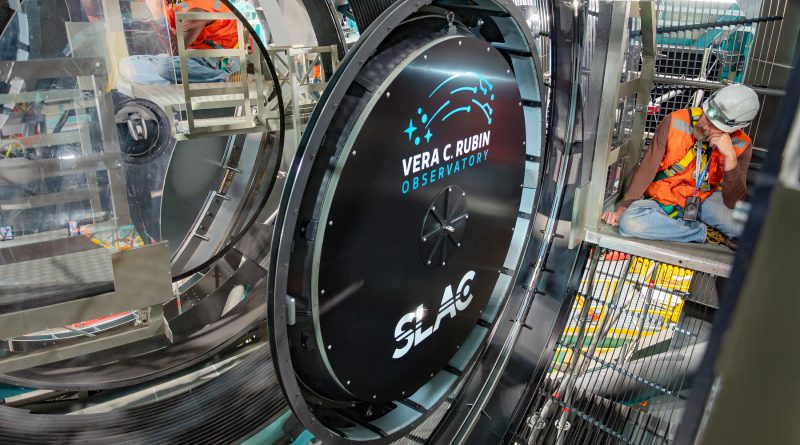The Vera Rubin Observatory installs the LSST camera on its telescope
The Vera Rubin Observatory has ahceived a major milestone with the installation of the LSST camera on its telescope. The installation of the final optical component marks the entry into the final phase of testing. The next step is to capture the First Look images before launching the LSST (Legacy Survey of Space and Time) survey. Equipped with the largest digital camera ever conceived, Rubin is preparing to collect an unprecedented volume of data on the visible universe, surpassing that of any other observatory in the world.
In early March, the team at the Vera Rubin Observatory, located on Cerro Pachón in Chile, successfully installed the imposing LSST camera, which is about the size of a car, on the Simonyi telescope. This major milestone crowns two decades of designing, building and transporting the camera to Chile. For Rubin, it also marks the entry into the final phase of testing, with the next steps being the publication of First Look images, followed by the launch, at the end of 2025, of the Legacy Survey of Space and Time (LSST), the major astronomical survey of the southern sky scheduled to last 10 years.
The LSST Camera was constructed at SLAC, incorporating cutting-edge technology to deliver an unprecedented view of the night sky. After the camera was completed in April 2024, the team transported it to Chile in a carefully coordinated effort to ensure its safe arrival at the Rubin Observatory.
With its 3200 megapixels and a weight of over 3 tonnes, the LSST camera is the largest digital camera ever built. In particular, it incorporates an innovative filter-changing system, which stores and alternately positions five large optical filters, each 75 cm in diameter and weighing 40 kilograms, in front of the lens, with a precision of a tenth of a millimetre. Teams from the CNRS Nuclei & Particles laboratories in France were responsible for producing this element, for which they were awarded a CNRS collective crystal in 2024. The filter changer occupies a central position in the Rubin Observatory’s optical system, alongside the combined 8.4-metre primary/tertiary mirrors and the 3.5-metre secondary mirror.
Using the LSST Camera, Rubin Observatory will repeatedly scan the southern night sky for a decade, creating an ultra-wide, ultra-high-definition time-lapse record of the Universe. This endeavor will bring the night sky to life, yielding a treasure trove of discoveries in our close universe (asteroids and comets, pulsating stars, and supernova explosions), as well as in the distant universe with the discovery of millions of new galaxies.
The data collected by Rubin will be stored at a rate of 20 terabytes per night. In France, the CC-IN2P3 centre in Lyon will contribute to its storage and processing. This data will be made available to scientists around the world at regular intervals, leading to revolutionary discoveries and major advances over the coming decades. Rubin data will be used by researchers around the world, enabling groundbreaking scientific discoveries and advancements that will help us understand our Universe better, chronicle its evolution, delve into the mysteries of dark energy and dark matter, and reveal answers to questions we have yet to imagine.
The LSST Camera utilities and other systems will be connected and tested over the coming weeks. This will be followed over several months by the essential commissioning phase, during which scientists and technicians will work together to make the final adjustments to the now-complete system. Soon the camera will be ready to start taking detailed images of the night sky, each one so large it would take a wall of 400 ultra-high-definition TV screens to display.

The LSST collaboration
The Rubin Observatory is a joint initiative of the National Science Foundation (NSF) and the US Department of Energy (DOE). Its main mission is to implement the LSST (Legacy Survey of Space and Time) project, providing an unprecedented data set for scientific research.
CNRS Nuclei & Particles is providing essential support for the construction and operation of the Rubin Observatory through the laboratories APC, CPPM, IJCLab, IP2I, LAPP, LPCA, LPNHE, LPSC, LUPM and CC-IN2P3. The institute is contributing, in particular, to the development of the telescope’s camera readout electronics and sensors, and to the camera’s filter changer system, while the computing centre is involved in data processing and storage.
The LSST Camera installation

More information
- CNRS Nuclei & Particles news: https://www.in2p3.cnrs.fr/fr/cnrsinfo/lobservatoire-vera-rubin-installe-la-camera-lsst-sur-son-telescope
- Rubin Observatory news: https://rubinobservatory.org/news/lsst-camera-installed
- LSST France website : https://www.lsst.fr/
- Rubin Observatory website: https://rubinobservatory.org/
- Images and videos: https://rubin.canto.com/v/ConstructionGallery/album/HDSNU?viewIndex=2&display=curatedView&from=fitView
Cover image: The LSST Camera installed on the Simonyi Survey Telescope at NSF–DOE Vera C. Rubin Observatory in March 2025.
Credit: RubinObs/NOIRLab/SLAC/NSF/DOE/AURA/B. Quint


